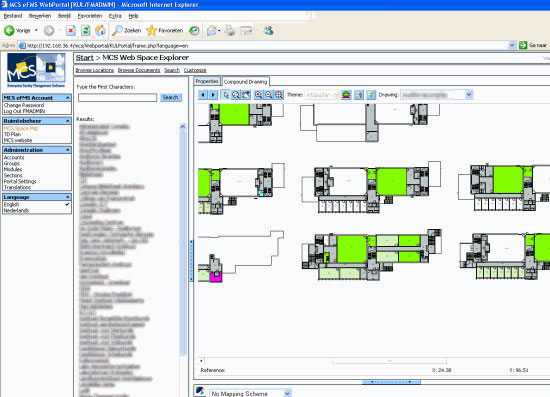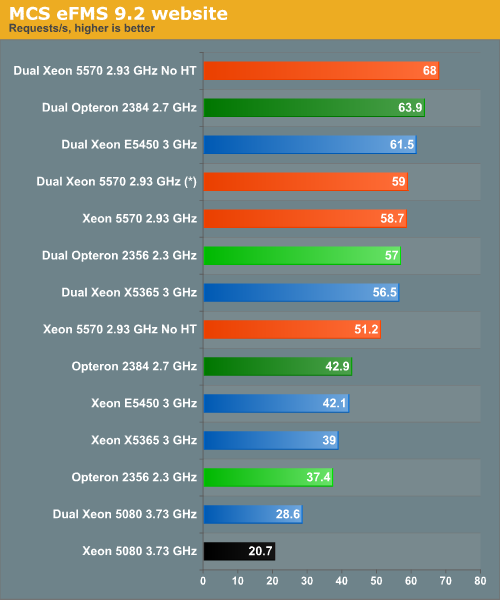The Best Server CPUs part 2: the Intel "Nehalem" Xeon X5570
by Johan De Gelas on March 30, 2009 3:00 PM EST- Posted in
- IT Computing
| Website: MCS eFMS (Windows 2003 32-bit EE) | |
| Operating System | Windows 2003 R2 - 32-bit |
| Software | MCS eFMS 9.2 |
| Benchmark software | vApus + real world "MCS" PHP site |
| Typical error margin | 1-2% |
One very interesting and processing intensive application that we encountered was the modular MCS Enterprise Facility Management Software (MCS eFMS), developed by MCS. The objective of eFMS is to integrate the management of space usage (buildings), assets and equipment (such as furniture, beamers etc.), cabling infrastructure, and others while keeping track of costs. MCS eFMS stores all information in a central Oracle database.

MCS eFMS integrates space management, room reservations and much more…
What makes the application interesting to us as IT researchers is the integration of three key technologies. First, it uses a web-based front end that integrates CAD drawings and gets its information from a rather complex, ERP-like Oracle database. It provides building overview trees of all rooms available and their reservations in a certain building. Finally, it allows users to drill down using the CAD drawing to get more detail. MCS eFMS is one of the most demanding web applications we have encountered so far. MCS eFMS uses the following software:
- Microsoft IIS 6.0 (Windows 2003 Server Standard Edition R2)
- PHP 4.4.0
- FastCGI
- Oracle 9.2
Large international companies such as Siemens, Ernst & Young, and Startpeople use MCS eFMS daily, which makes testing this application even more attractive. We tested with both single CPU and dual CPU configurations.

(*) CPU load was at 50-55%.
For once, the Opteron stays in the slipstream of the Xeon X5570. If you look at the single CPU results, you can see that something went wrong: the Xeon X5570 with HT enabled is about 37% faster than the Opteron at 2.7GHz, but once we add a second Xeon X5570, the website refuses to perform better. Without Hyper-Threading, adding four more cores leads to a 32% performance increase from 51.2 responses per second to 68 responses per second. This seems to be something PHP related, as there are too few PHP threads to actually absorb CPU power. The result is that the dual Xeon X5570 with Hyper-Threading enabled is only loaded at 50%-55%, clearly indicating that the PHP site is not making use of the 16 logical cores. Windows 2003 R2 does not seem to schedule its threads optimally in that case.
This real world test shows that not all applications are capable of scaling up easily. We know from previous tests that this application scales out when you use load balancing. If we only look at the single CPU performance, which is quite common in the website market, we can conclude that Xeon X5570 is about 37% faster than its best competitor and 39% faster than its predecessor (Xeon 54xx). At that point both CPUs are running at 80 to 100% CPU load. You would almost be disappointed after all the spectacular performance numbers that the latest Xeon produced, but a 37% performance advantage is still very impressive.










44 Comments
View All Comments
usamaah - Monday, March 30, 2009 - link
Is it me or is page 2 of this article missing some information? The title of that 2nd page is "What Intel and AMD are Offering," but in the body of the text there are only descriptions of Intel's Xeon chips? Perhaps a new title to reflect the body, or add AMD info?JohanAnandtech - Monday, March 30, 2009 - link
I moved the AMD vs Intel pricing data to the back of the article as the pricing info is more interesting once you have seen the results. But forgot to change the title.. fixed. Thanks.usamaah - Monday, March 30, 2009 - link
Cool, thank you. Next time I'll finish reading the article before I make a comment, sorry ;-) Anyway wonderful article.Ipatinga - Monday, March 30, 2009 - link
Very nice to see a comparison over some generations of Xeon platform, including the new one (yet to be released).I would like to see a new article with Core i7 vs Xeon 5500... to check out if my Core i7 @ 3,7GHz is good enough in Maya 2009 (Windows XP 64bit, 12GB DDR3), or if a Xeon 5500 (each at 2,4GHz, for instance) in dual processor configuration will be a much better buy.